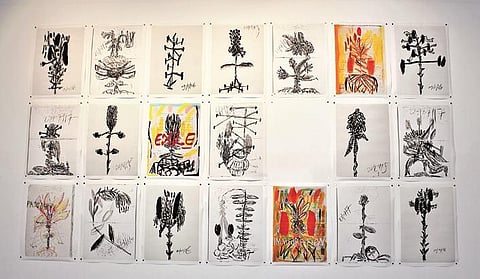

A deeper examination of Israel’s complicated internal dynamics, ‘In Another Green’ has been curated by Achia Anzi, an Israel-born artist who is currently working as an assistant professor at the Jindal School of Liberal Arts and Humanities.
On display at the Galerie Romain Rolland, Alliance Française de Delhi, till December 18, this exhibition showcases works by two artists—Leor Grady (55) and Yosef Joseph Yaakov Dadoune (46), and is centred around the Eastern Jewish community’s struggle against coloniality—a theory that talks about the cultural, political, and economical domination of the West.
Speaking about the theme, Anzi mentioned, “Theoretically, the approach of this exhibition is that colonialism did not just have an impact on the places that were under direct colonial rule, but in general, the relationship between the so-called East and West.” Organised by the Embassy of Israel in collaboration with Alliance Française de Delhi, the exhibition touches upon Zionist history and their coming back to Israel.
Conflicting identities
While Grady is from the Yemeni community, Dadoune has roots in both Algeria and France. Both these communities were considered the ‘other’ by European Zionists. “On the one hand, Zionists were fascinated by the Yemini community. But on the other hand, they were considered primitive,” Anzi explained, correlating this attitude to the European attitude towards India.
On walking into the gallery, Dadoune’s video piece titled ‘In the Desert’, which depicts a barren desert landscape where cypress and palm trees are being buried, is the first thing to catch one’s eye. To its right there are flowers sketches, intersected with a set of two video installations. The footage shows, in sequence, a small, provincial Israeli town, and the artist himself suspended above the ground with cables. Dadoune said, “I started to see how the desert was erased by the massive construction project in the Middle East... The series of black flowers expresses human fragility in times of war in Tel Aviv.”
Grady’s works include a series of photographs of bouquets made out of herbs common in Arab-Jew backyards; a carpet cut-out in the shape of the Sea of Galilee; and a video titled ‘Eye and the heart’ split into two sections, which play side-by-side. The video to the left is of a Yemeni dancer who embodies the culture itself, while on the right, two professional dancers (not Yemini) attempt to mimic traditional movements. Speaking about his struggle with identity, Grady said, “Born in Israel to Yemeni parents, I was conditioned to follow the notion that our non-western cultural aesthetics are rather basic. As such it is the ‘other’ culture, the fringe/queer culture that can or might be appreciated to some degree and ‘exotic’ context, as long as it stays there (entertaining and devoid of funding). Today, I’m committed to expressing its beauty and history, by deciphering the visual vocabulary it speaks.”
Talking about the two artists, Achia concludes, “Dadoune and Grady are important artists, representing this new voice of Eastern artists who are not hiding their identity.”